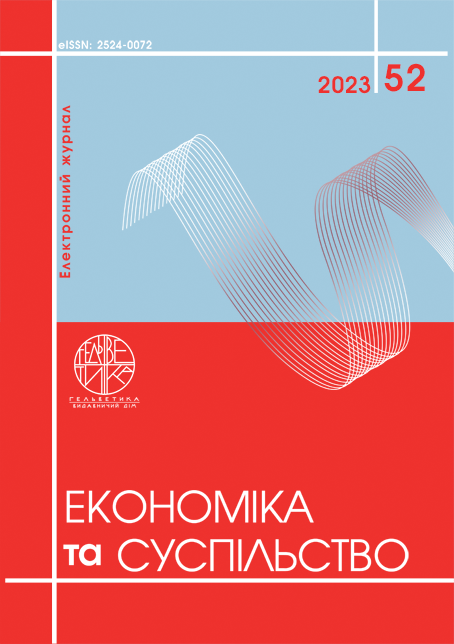INTERNATIONAL STANDARDS AND STATISTICAL METHODS REGARDING RISK ASSESSMENT IN THE ACTIVITIES OF INTERNATIONAL ORGANIZATIONS
Abstract
The problem of risk measurement has always required attention, and methods of reducing the impact of risks on the results of financial activity attract the attention of economists both from a theoretical and practical point of view. A number of bankruptcies of companies, banks, hedge funds and institutional investors that have been observed in recent years have contributed to increased attention to this problem. Note that the perspective, multifacetedness and relevance of the problem of risk assessment and management using statistical methods has a large number of aspects that require careful research. The assessment of financial risks of the activities of international organizations is also a relevant issue, as it is often aimed at their development and survival. This article analyzes the concept of financial risk, examines the existing statistical methods of risk assessment, international standards for risk assessment, their advantages and disadvantages. The analysis of existing risks was carried out and the practical use of statistical methods for risk assessment in the activities of international organizations was proposed. Considerable attention is paid to solving issues of statistical methods of risk assessment, as evidenced by the research of domestic and foreign scientists. Having processed various sources and publications, it is possible to conclude that there is no integral theory of financial risk assessment in domestic science and the optimal statistical method for its assessment in the activities of both domestic and international organizations has not been determined. The purpose of this study is to analyze and refine existing statistical methods, formulate one's own vision regarding this problem, justify the feasibility of using these methods in specific conditions. In the course of the research, economic-statistical, analog and expert methods were used. The practical value of the article consists in the fact that the article proposed, in accordance with international standards, for the assessment of financial risks in international organizations, to compile a two-level model for assessing financial risks, gave recommendations for assessing risk with the help of this module, and proposed a model of the probability of the occurrence of risks and their evaluations. We consider it expedient to extend the study of the issue of financial risk assessment, regarding the use of digital technologies, with the aim of timely clarifying the sources of financial risks.
References
Вітлінський В.В., Скіцько В.І. Ризик-менеджмент ланцюгів постачання в умовах цифрової економіки. Бізнес Інформ. 2018. № 4. С. 384–392. URL: http://nbuv.gov.ua/UJRN/binf_2018_4_55
Риженко О., Фіщук В. Як цифрова економіка змінить Україну. Економічна правда. 2018. 16 січня. URL: https://www.epravda.com.ua/columns/2018/01/16/633057/
Фіщук В. Цифрова економіка – це реально. Новий час. Бізнес. 18 квітня 2017 р. URL: https://biz.nv.ua/ukr/experts/fichuk/tsifrova-ekonomika-tse-realno-1001102.html
Diedrich K. Framework for Digitalized Proactive Supply Chain Risk Management. Proceedings of the Hamburg International Conference of Logistics (HICL). Digitalization in Supply Chain Management and Logistics. 2017. P. 381–403. URL: https://tubdok.tub.tuhh.de/bitstream/11420/1459/1/diedrich_framework_digitalized_supply_chain_hicl_2017.pdf
Schlüter F., Henke M. Smart Supply Chain Risk Management – A Conceptual Framework. Proceedings of the Hamburg International Conference of Logistics (HICL). Digitalization in Supply Chain Management and Logistics. 2017. P. 361–380. URL: https://tubdok.tub.tuhh.de/bitstream/11420/1469/1/schl%c3%bcter_henke_smart_supply_chain_risk_hicl_2017.pdf
The Future of Risk Management in the Digital Era. October 2017. Portilla A., Vazquez J., Harreis H. at al. Editor: M. Staples. URL: https://www.mckinsey.com/~/media/McKinsey/Business%20Functions/Risk/Our%20Insights/The%20future%20of%20risk%20management%20in%20the%20digital%20era/Future-of-risk-management-in-the-digital-era-IIFand-McKinsey.ashx
Camillo M., Overton M. Cyber Risks and Your Supply Chain. 03/29/2017. URL: https://www.aig.com/knowledge-andinsights/k-and-i-article-cyber-supply-chain
Moss C. Cybersecurity in the Digital Supply Chain: Managing Third-Party Risk Through Verified Trust. URL: http://www.digitalistmag.com/digital-supply-networks/2017/03/14/cybersecurity-in-digital-supply-chain-managing-third-partyrisk-through-verified-trust-04958505
Бланк І.А. Фінансовий менеджмент : підручник. Київ : Ніка-Центр, Ельга, 2001. 528 с.
Національний банк України. Моделі оцінки ризиків. Департамент фінансового моніторингу. URL: http://www.4_рr_2020-11-20pdf
Vitlinskyi V.В., & Skitsko V.I. (2018) Ryzyk-menedzhment lantsiuhiv postachannia v umovakh tsyfrovoi ekonomiky [Risk management of supply chains in the digital economy]. Biznes Inform. 4. 384–392. Available at: http://nbuv.gov.ua/UJRN/binf_2018_4_55 [in Ukrainian]
Ryzhenko O., & Fishchuk V. (2018) Yak tsyfrova ekonomika zminyt Ukrainu [How the digital economy will change Ukraine]. Ekonomichna pravda. 16 sichnia. Available at: https://www.epravda.com.ua/columns/2018/01/16/633057/ [in Ukrainian]
Fishchuk V. (2017) Tsyfrova ekonomika – tse realno [The digital economy is real]. Novoe vremia. Biznes. 18 kvitnia. Available at: https://biz.nv.ua/ukr/experts/fichuk/tsifrova-ekonomika-tse-realno-1001102.html [in Ukrainian]
Diedrich K. (2017) Framework for Digitalized Proactive Supply Chain Risk Management [Framework for Digitalized Proactive Supply Chain Risk Management]. Proceedings of the Hamburg International Conference of Logistics (HICL). Digitalization in Supply Chain Management and Logistics. 381–403. Available at: https://tubdok.tub.tuhh.de/bitstream/11420/1459/1/diedrich_framework_digitalized_supply_chain_hicl_2017.pdf
Schlüter F., & Henke M. (2017) Smart Supply Chain Risk Management – A Conceptual Framework [Smart Supply Chain Risk Management – A Conceptual Framework]. Proceedings of the Hamburg International Conference of Logistics (HICL). Digitalization in Supply Chain Management and Logistics. 361–380. Available at: https://tubdok.tub.tuhh.de/bitstream/11420/1469/1/schl%c3%bcter_henke_smart_supply_chain_risk_hicl_2017.pdf
Portilla A., & Vazquez J., & Harreis H. (2017) The Future of Risk Management in the Digital Era [The Future of Risk Management in the Digital Era] Editor: M. Staples. Available at: https://www.mckinsey.com/~/media/McKinsey/Business%20Functions/Risk/Our%20Insights/The%20future%20of%20risk%20management%20in%20the%20digital%20era/Future-of-risk-management-in-the-digital-era-IIFand-McKinsey.ashx
Camillo M., & Overton M. (2017) Cyber Risks and Your Supply Chain [Cyber Risks and Your Supply Chain]. Available at: https://www.aig.com/knowledge-andinsights/k-and-i-article-cyber-supply-chain
Moss C. (2017) Cybersecurity in the Digital Supply Chain. Managing Third-Party Risk Through Verified Trust [Cybersecurity in the Digital Supply Chain: Managing Third-Party Risk Through Verified Trust]. Available at: http://www.digitalistmag.com/digital-supply-networks/2017/03/14/cybersecurity-in-digital-supply-chain-managing-third-partyrisk-through-verified-trust-04958505
Blank I.A. (2001) Finansovyi menedzhment [financial management] : pidruchnyk. Kyiv : Nika-Tsentr, Elha, 528. [in Ukrainian]
Natsionalnyi bank Ukrainy. Modeli otsinky ryzykiv. Departament finansovoho monitorynhu (2020) [National Bank of Ukraine. Risk assessment models. Department of Financial Monitoring]. Available at: http://www.4_rr_2020-11-20pdf [in Ukrainian]

This work is licensed under a Creative Commons Attribution 4.0 International License.


